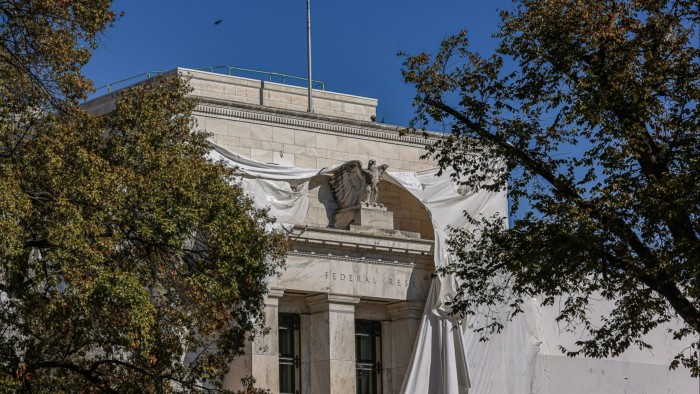Hot on the heels of Donald Trump’s decisive US presidential election victory and a Federal Reserve interest rate decision, inflation data on Wednesday may provide clues for investors about the future path of monetary policy.
Economists polled by Reuters are expecting October’s consumer price index growth to come in at 2.6 per cent year-on-year, slightly higher than the 2.4 per cent recorded a month ago. The reading for September had marked an easing of the pace of inflation, but still came in above consensus forecasts.
Stripping out volatile items such as food and energy, core inflation is expected to have held steady at 3.3 per cent last month.
Following a flurry of broadly strong economic data, the Fed this week cut US interest rates by a widely anticipated 0.25 percentage points to a target range of 4.5 to 4.75 per cent, having implemented a jumbo-sized half-point cut in September.
With traders betting that president-elect Trump’s campaign policies of trade tariffs and tax cuts will be inflationary, markets are now pricing in less than one percentage point of cuts by the end of next year.
Neil Sun, BlueBay portfolio manager at RBC Global Asset Management, said his team expects another quarter-point rate cut in December, “while the outlook for 2025 remains uncertain as investors await clarity on policy impact under ‘Trump 2.0’”.
“We believe that an inflationary trade war would limit the Fed’s ability to cut rates in 2025.” Harriet Clarfelt
Is UK GDP growth still slowing?
UK economic growth is expected to have slowed significantly in the third quarter of the year, a blow to the new Labour government’s pro-growth agenda but a likely help in the Bank of England’s fight against inflation.
Economists surveyed by LSEG predict GDP data on Friday will show a quarter-on-quarter growth rate of 0.2 per cent for the three months to September. That is below the 0.5 per cent in the previous quarter, and the 0.7 per cent in the first quarter when the UK economy was recovering from last year’s technical recession.
“This is hardly a stellar pace, at a time when household incomes will have benefited from above-inflation wage growth,” said Sandra Horsfield, an economist at Investec, who shares the consensus forecast.
However, by falling somewhat short of potential, this pace of expansion is letting a little steam out of underlying price pressures, making it more likely that inflation — currently below target — can be sustained at target in the medium term, she said.
“As such, it gives more room for the [BoE’s] monetary policy committee to continue cutting rates, without suggesting there is much urgency to do so,” said Horsfield.
The BoE cut interest rates for the second time this year to 4.75 per cent this week. It expects economic growth to fall back to 0.2 per cent in the third quarter and 0.3 per cent in the final three months of the year.
Governor Andrew Bailey said he expected rates to “continue to fall gradually from here”, with many economists expecting US president-elect Trump’s plans for trade tariffs to stoke inflation.
The BoE also estimated that the measures announced in the Budget last month will boost GDP by around 0.75 per cent in a year’s time, relative to its August projections. It also expects inflation to be about 0.5 of a percentage point higher at its peak at the end of next year at 2.7 per cent. Valentina Romei
Is the euro headed for parity with the dollar?
The prospect of tariffs and tax cuts under US president-elect Donald Trump has sent the euro lower with some analysts even expecting the currency to fall to parity with the dollar.
ING expects the currency to trade between $1.00 and $1.05 over the coming quarters, with “peak pressure” towards the end of next year when tight fiscal conditions will pair with Trump’s team seeking trade concessions with Europe.
“We think it will probably be knocking on parity’s door by late 2025,” said Chris Turner, global head of markets at the Dutch bank.
The euro experienced the largest decline of any G10 currency against the dollar in the wake of the US presidential election, falling 1.9 per cent on Wednesday. On Friday it was trading at around $1.072.
Trump’s victory comes as investors expect the European Central Bank to cut interest rates much faster than the US Federal Reserve. While strong economic data has reduced bets on US rate cuts, data in the Eurozone has been weaker.
Eurozone inflation rose to 2 per cent in October, meeting the ECB’s target, and helping spur swap markets to price in an 86 per cent probability of a 0.25 percentage point rate cut next month, according to LSEG data.
Jussi Hiljanen, chief strategist at SEB, said that a “post-election honeymoon” would help boost the dollar.
“It is difficult to find any substantial European factors that could weigh against [the currency’s strength] in the short run,” he said, adding that the political backdrop in Europe “remains bleak”. Rafe Uddin
https://www.ft.com/content/1f8e88bf-110f-4c99-85dc-5f74706518ac


